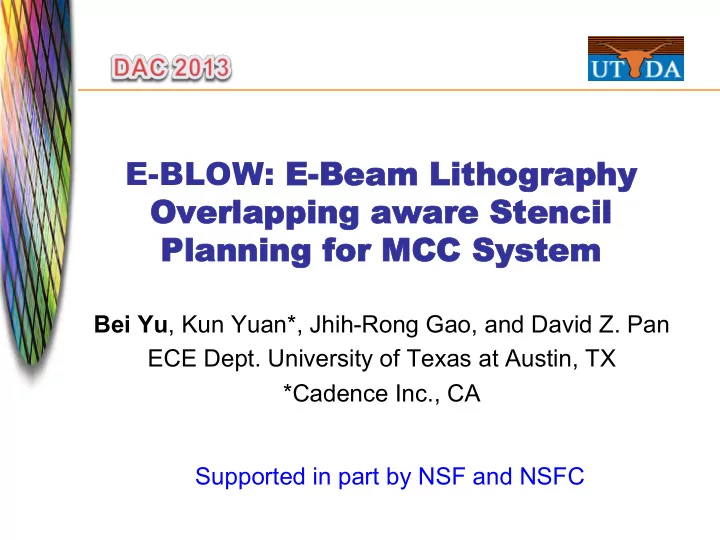

E-BLOW: E-B -Beam eam Lit Lithogr hography aphy Ov Over erlapping lapping aw awar are e Stencil encil Planning lanning for or MCC System em Bei Yu , Kun Yuan*, Jhih-Rong Gao, and David Z. Pan ECE Dept. University of Texas at Austin, TX *Cadence Inc., CA Supported in part by NSF and NSFC
Int ntroduct oduction– ion– E-B -Beam eam t E-Beam lithography: › Several decades, for mask manufacturing › Candidate for next generation lithography, with MPL/EUV/DSA t Conventional E-Beam system: › variable shaped beams ( VSB ): shaping aperture + second aperture › Character Projection ( CP ): a pattern ( character ) is pre-designed on the stencil , then it can be printed in one electronic shot; Electrical Guns Electrical Gun Shaping Apentures Shaping Apenture 2nd Apenture 2 Stencil 1 3 Wafer Wafer 2
Int ntroduct oduction– ion– MCC system em t Multi-Column Cell (MCC) system › Several independent character projections (CP) to speed-up › Each CP is applied on one section of wafer. › Share one stencil design Electrical Guns MCC system with 4 CPs Shaping Apentures 4 stencils share 1 design Stencils 4 Regions on Wafer w1 w2 w3 w4 3
Introduction– MCC system Shot# t MCC system with: › P CPs, wafer is divided into P regions › n character candidates (patterns) {c 1 , … , c n } t ic w c › For c i , its VSB shot# is ni ; repeat on region › a i : indicate whether c i is selected on stencil t Total shot# for region : w c With stencil, CP shot# Without stencil, VSB Shot# t MCC system writing time: 4
Problem oblem For Formulat mulation ion Overlapping aware Stencil Planning (OSP) Problem: t Input: set of characters; MCC system info t Output: selected characters, pack them on stencil t Objective: minimize MCC system writing time t 1D-OSP and 2D-OSP problems: F D E F D E C A A B C B 5
Problem Formulation-- Complexity t Lemma 1 : 1D-OSP is NP-hard D E F › Reduced from Multiple-Knapsack problem A B C t Lemma 2 : 2D-OSP is NP-hard F E D › Reduced from Strip Packing problem C A B t New challenges for MCC system: E-BLOW ① New total shot# functions ② More character number (more than 4000) 6
E-BLOW for 1D-OSP t ILP formulation › NP-hard to solve ILP, runtime penalty. › LP relaxation cannot be applied here. Why? (a ik = a jk = 0.5) 7
E-BLOW for 1D-OSP (cont.) t Simplified ILP formulation t Theorem : The LP Rounding solution of (3) can be a 0.5/ α − approximation to program (3’), where (3’) is a similar multiple knapsack problem. 8
E-B -BLOW LOW for or 1D 1D-OS -OSP (cont cont.) .) t Novel iterative solving framework to near-optimal solution t LP relaxation with lower bound theoretically t Successive rounding t Dynamic programming based refinement Regions Info Apply S-Blank Characters Assumption Info Update LP Simplified LP Formulation Solve New LP Successive Rounding No Finish? Refinement Yes Output 1D-Stencil 9
E-BLOW for 2D-OSP t Simulated annealing based framework. t Sequence Pair as topology representation. t Pre-filter process to remove bad characters. t Clustering is applied to achieve speedup. Regions Info Pre-Filter Characters Info KD-Tree based Clustering Simulated Annealing based Packing Output 2D-Stencil 10
E-BLOW for 2D-OSP (cont.) t KD-Tree based Clustering › Speed-up the process of finding available pair; › From O(n) to O(logn); › For c2 to find another candidate with the similar space, only scan c1 − c5. Vertical Space c9 c4 c5 c5 c8 c2 c7 c2 c7 c1 c3 c4 c6 c8 c6 c3 c1 c9 Horizontal Space 11
1D-OSP Writing Time Comparison 1,000,000 900,000 Greedy in [TCAD’12] 800,000 [TCAD’12] Shot Number for 1D cases E − BLOW 700,000 600,000 500,000 400,000 300,000 200,000 100,000 0 1 2 3 4 5 6 7 8 1 2 3 4 M M M M M M M M D D D D − − − − − − − − − − − − 1 1 1 1 1 1 1 1 1 1 1 1 t For 1D cases, greedy algorithm introduces 47% more wafer writing time, and [TCAD’12] introduces 19% more wafer writing time. 12
2D-OSP Writing Time Comparison 1,400,000 Greedy in [TCAD’12] [TCAD’12] 1,200,000 E − BLOW Shot Number for 2D cases 1,000,000 800,000 600,000 400,000 200,000 0 2M − 1 2M − 2 2M − 3 2M − 4 2M − 5 2M − 6 2M − 7 2M − 8 2D − 1 2D − 2 2D − 3 2D − 4 t For 2D cases, greedy introduces 30% more wafer writing time, while [TCAD’12] introduces 14% more wafer writing time. 13
CPU Runtime Comparison 10,000 [TCAD’12] E − BLOW 1,000 Runtime (s) 100 10 1M − 1 1M − 2 1M − 3 1M − 4 1M − 5 1M − 6 1M − 7 1M − 8 2M − 1 2M − 2 2M − 3 2M − 4 2M − 5 2M − 6 2M − 7 2M − 8 1D − 1 1D − 2 1D − 3 1D − 4 2D − 1 2D − 2 2D − 3 2D − 4 1 t Compared with [TCAD’12], E-BLOW can reduce 34.3% of runtime for 1D cases, while 2.8 × speedup for 2D cases. 14
Conclusion t E-BLOW, a tool to solve OSP problem in MCC system. t E-BLOW can achieve better performance in terms of wafer writing time and CPU runtime, for both MCC system and traditional E-Beam system. t E-Beam is under heavy R&D, including massive parallel writing. › More research to improve the throughput of E-Beam › More research on the E-Beam-aware design 15
t Thank You 16
Recommend
More recommend